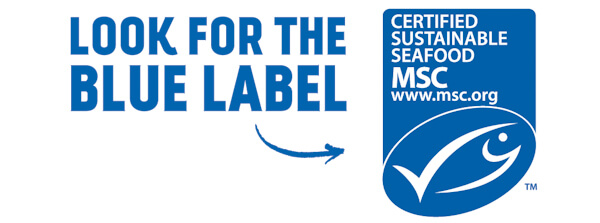‘FAD free tuna’ is tuna caught without a Fish Aggregating Device (FAD). Fishing with FADs can sometimes increase the likelihood of bycatch. However, if managed well FADs can increase the efficiency of fishing and be deemed sustainable.
What is a Fish Aggregating Device (FAD)?
A Fish Aggregation Device (FAD) is a floating object that casts a shadow into the water to attract groupings of fish. By casting their nets and fishing rods near these floating objects, fishers can increase their catches with less effort. This can, however, result in a higher level of bycatch.
FADs can be classified as entangling and non-entangling. Traditionally FADs were produced using nets or meshed materials. These nets could accidentally trap species such as sharks and turtles. Non-entangling FADs use ropes or nets rolled up to avoid entangling marine fauna.
Types of Fish Aggregating Devices (FADs)
- Natural FADs are made of natural structures or floating objects, including free-floating logs (tree trunks) and large marine animals, such as whale sharks, around which fish congregate. This is referred to as ‘natural-associated’ or ‘object-associated’ fishing.
- Anchored FADs are rafts – often made of bamboo – fixed to an anchored buoy, usually in coastal waters. Anchored FADs (often referred to as aFADs) can be either non-entangling or entangling. They are used by both commercial and subsistence fisheries and are most commonly associated with pole and line fishing. The FAD stays in the same position and doesn’t drift, reducing the risk of it getting lost or damaging reefs.
- Non-entangling dFADs drift with ocean currents and winds. Non-entangling dFADs use ropes or rolled-up nets to avoid entangling marine creatures. Each dFAD has a buoy with a reference number and a GPS unit so the fishermen can find them
- Entangling dFADs have nets that hang in the water column from a floating structure
- Biodegradable FADs - Several companies have begun using non-entangling, biodegradable FADs to reduce the impact of discarded FADs on coral reefs and to reduce the rate of plastics entering the ocean.
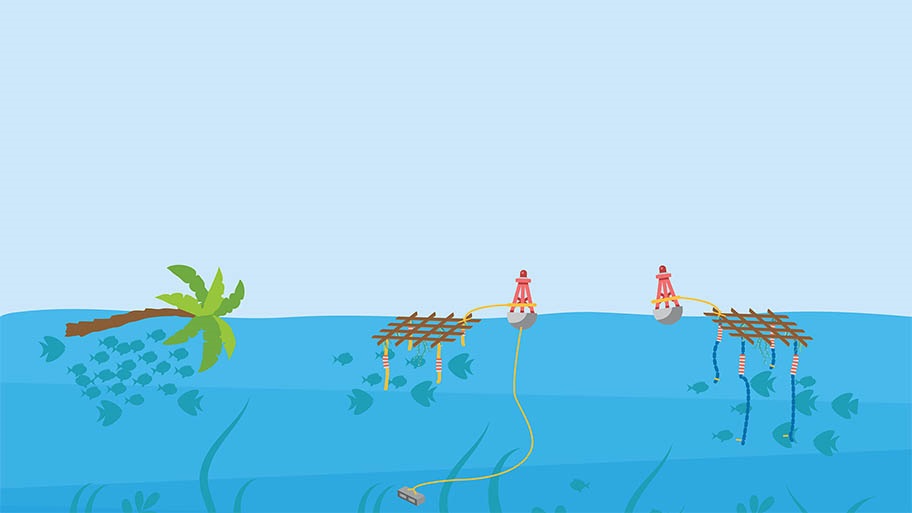
Natural FAD, Anchored FAD (aFAD) and drifting FAD (dFAD)
How are FADs used in fishing?
There are different types of FADs such as drifting FADs that float in the sea (dFAD) and anchored FADs (aFAD) that are anchored to the seabed. The Indian Ocean Tuna Commission (IOTC) defines a dFAD as being equipped with instrumented buoys to aggregate species of tuna. Buoys are marked with a reference number allowing its identification and equipped with a satellite tracking system to monitor their position. Some FADs are even equipped with sonar which lets fishers know when and where to fish and can even identify the species of fish underneath.
Some fishers use natural objects, such as tree trunks floating in the water or the presence of large marine animals that fish like to gather around. This is referred to as ‘natural-associated’ or ‘object-associated’ fishing.
Should I only eat FAD free tuna fish?
Sustainable seafood can be caught using various fishing methods and gear types, including fishing methods and gear types, including the use of Fish Aggregating Devices (FADs).
The fishing method used is just one factor when considering the environmental impact of fishing activity.
Certification to the MSC Fisheries Standard is based on comprehensive assessment of the impacts of a particular fishery and the environment within which it operates.
The latest version of the MSC Fisheries Standard, published in October 2023, contains strengthened requirements to minimise gear loss and mitigate the impacts of lost gear. These requirements also apply to FADs: fisheries now need to account for any FADs that are lost and be able to demonstrate they are avoiding and managing this loss. This includes tracking or retrieving FADs, or showing they are low-impact by being non-entangling and biodegradable.
Increasingly consumers are looking for claims to be independently verified.
When looking at claims of FAD-free fish, be sure it comes from a trusted source, that the claim is independently verified, and that the fish can be traced back to its source.
To be sure you’re purchasing sustainable seafood, look for the MSC blue fish tick label.
What are the problems associated with FAD fishing?
- Marine life mortality: A wide variety of marine life including turtles and sharks congregate around FADs. These species can become entangled in the floating nets attached to FADs.
- Bycatch: Such "non-target" species can also be caught as bycatch (accidental catch) in the nets or lines fishers cast from their boats to catch the tuna. As a result, bycatch can be high when fishing around FADs, particularly in comparison to free school fishing, where nets are set in the open water.
- Ecosystem impacts: High amounts of bycatch can have detrimental impacts on the ecosystem. FADs can also increase the capture of juvenile tuna, putting the sustainability of some tuna stocks at risk.
However, species interact differently with different types of FADs, and different fishing techniques can make dramatic differences in the level of bycatch.
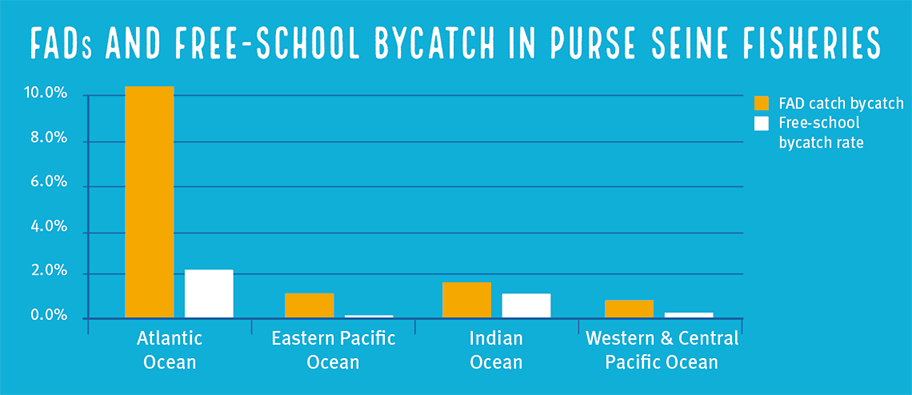
Source: ISSF, 2019. International Workshop on Mitigating Environmental Impacts of Tropical Tuna Purse Seine Fisheries
In addition to bycatch concerns, the potential effects of FADs on the migratory patterns of tuna are the subject of ongoing research. The impacts of lost or derelict FADs on habitats such as coral reefs and in contributing to ocean plastic are also a concern.
With an estimated 81,000-121,000 FADs deployed worldwide each year, the cumulative impact of FADs can be damaging if not managed effectively.
Can FAD fishing be sustainable?
Fishing activities that use FADs can be deemed sustainable where the use is well managed. To be certified sustainable to the MSC Fisheries Standard, fishing managers must demonstrate that the impact of their fishing activity does not damage the marine ecosystem and populations of fish. This fishing activity is assessed by a team of scientists. If the fishery is certified, annual surveillance audits check to see if the fishing activity is still sustainable. If not, the certificate is suspended and seafood from that source can no longer be sold using the blue fish tick label.
Read more about why ‘FAD’ does not always mean ‘bad’.
How jellyfish inspired the design of the 100% biodegradable ‘jelly-FAD
The MSC asked tuna conservation biologist Dr. Gala Moreno, world authority about sustainable Fish Aggregating Devices (FADs).
Dr. Moreno explains that FADs, once the scourge of tuna fishing, have evolved and how the jellyfish inspired her to co-design the 100% biodegradable ‘jelly-FAD’, made from locally sourced materials.
This innovation has been adopted by sustainable fisheries worldwide and is reducing plastic pollution, helping to end overfishing and minimising fishing impacts on endangered species and marine habitats
The world's first FAD fishery to gain MSC certification
The film tells the story of how Echebastar went on a decade-long journey to become the first FAD fishery in the world to gain MSC certification. It explains how despite two assessment failures, the fishery persisted and finally gained certification on the third attempt.
The film shows the complexities and controversies of FAD fishing, but also how such a gear type can be used to fish sustainably.
Improvements with FAD tuna fishing
To improve the sustainability of FADs, in the last decade, MSC-certified fisheries have...
- changed the design of FADs to become non-entangling and biodegradable
- improved the management of the FADs, such as reducing the number of FADs in use; seasonal closing times for FADs; improving the handling of bycatch; tracking and control of FADs, and the implementation of retrieval policies for lost FADs
- trialed new sonar technology, which allows them to see the type of fish beneath the FADs before setting their nets
- supported scientific research, e.g. on the impacts of lost FADs on ecosystems such as coral reefs.
In 2018, the MSC awarded a Student Scholarship Grant to a postgraduate student who identified a new method of tracking anchored FADs in Indonesian waters. The aFads used by small-scale Indonesian fishers are locally known as "rumpon" and often consist of coconut or palm leaves used to attract fish with their aromas.
Despite new government regulations being introduced to manage aFADs in the western Pacific Ocean, rumpon remain largely undocumented and overfishing can quickly occur. Analysis showed that by engaging the local fishing community to voluntarily fix satellite trackers to their vessels, FAD use patterns can be identified and the chance of overfishing reduced.

Bycatch reduction devices
A key component of sustainable fishing, bycatch reduction devices have been an integral part of long-term marine-life protection.
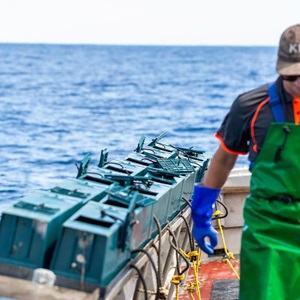
What is bycatch?
What is bycatch, why it's a problem and how it is reduced.
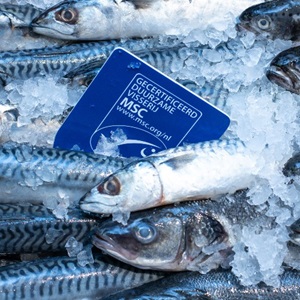
The MSC standards
Up to date globally-recognised framework for assessing a fishery's sustainability and management.

